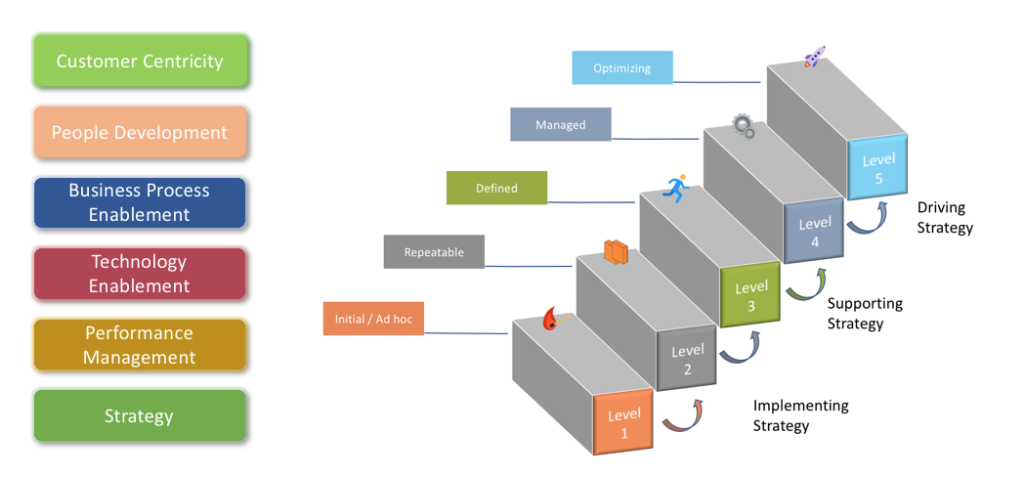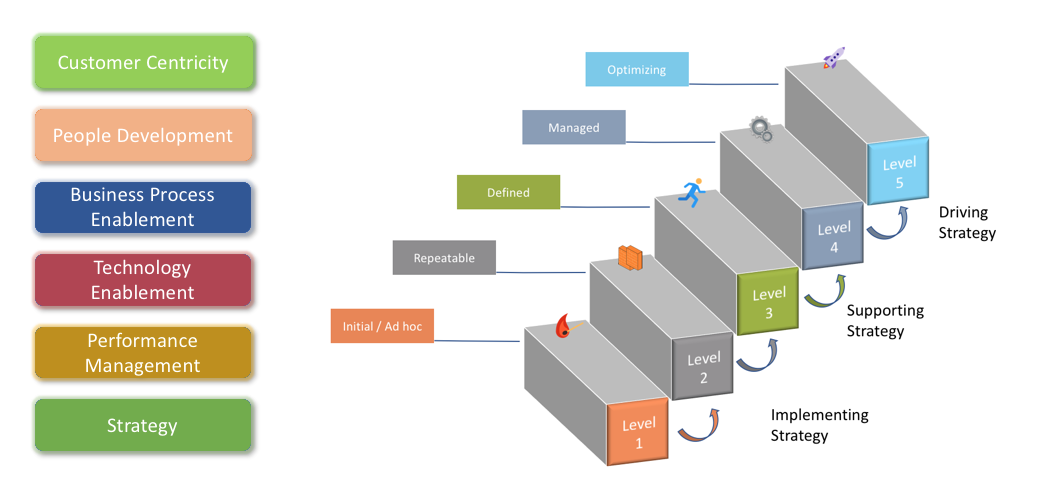Overview of the Capability Maturity Model
The Capability Maturity Model (“CMM”) was originally developed as a tool that would enable objective assessment of government contractors’ development processes to implement a contracted software project. Although the model was originally created to support software development, its use to evaluate business processes more generally has become commonplace in government, commerce, and industry.
Before going any further, it may be helpful to talk a little about why anyone would want to use a model created to support software development to evaluate a company’s ability or readiness to address customer experience.
For the purposes of this discussion, let’s assume that we all agree that the ability to support omnichannel communications is a key goal that organizations typically define as critical or key to achieving their customer experience goals. Now let’s assume that an organization being evaluated using the CMM actually has a “state-of-the-art” contact center communications platform that has the ability to delivery omnichannel communications with all the bells and whistles you could possibly imagine. And, finally, let’s also assume that this particular organization’s IT department has done a great job of implementing the communications platform along with all the features of our state-of-the-art communication platform’s omnichannel capabilities.
If we were to grade the organization on a scale of 1-5, which is in essence what we do with the CMM, should we give the organization a 5 in the capabilities related to omnichannel communications? The answer, as you might imagine, based on what we know so far is No. Based on what we know at this point, it’s probably a 1 in fact.
CMM’s are not designed or intended to measure or evaluate what is implemented to support a given capability (omnichannel communications in this case or more specifically, a capability related to it) or even how a given component or process is implemented.
CMM’s are specifically and purposefully designed to evaluate how a given capability is integrated into the environment in support of the desired outcome. In our example, the outcome for the sake of argument is to enhance our customer’s experience in the use of the company’s products and services, specifically by giving the customer the option to communicate with the company using the channel that is most convenient or most appropriate (to them, not the company) at that particular moment in time.
Referring back to our example, simply having a state-of-the-art platform that is capable of delivering omnichannel in no way ensures that our customer’s experience with that capability is going to meet either their expectations or the company’s business goals and objectives related to customer engagement. In order to be successful in this regard, the capability needs to be integrated with a variety of other business processes. For example, workforce management, skills management, interaction routing, reporting and analytics, training, quality assurance, etc.. It also needs to be utilized and managed (administratively and operationally) using documented procedures that are proven to work in a variety of conditions. The use of the system, both from the agent and the customer perspectives needs to be monitored and qualitatively measured in order to ensure that both the system and the process are performing as expected and are achieving the desired result consistently. And, any changes to outcomes should be identified and acted upon in a systematic way to enable continuous improvement. If all these things are true, our fictitious company would likely score 5 for this capability. The culmination of these various factors in support of a broad range of capabilities is rare, as you might imagine but it’s important to note that achieving level 5 across the board is neither required nor recommended (as an aspiration).
Our Capability Maturity Model uses a theoretical continuum along which capability maturity can be measured incrementally from one level to the next. As shown in the figure below, the continuum includes five (5) levels of maturity.

Maturity Model Levels and Descriptions
Please note that level descriptions and other material were adapted from source(s) available at https://en.wikipedia.org/wiki/Capbility_Maturity_Model
- Level 1 – Initial/Foundational
– It is characteristic of processes at this level that they are [typically] undocumented and in a state of dynamic change, tending to be driven in an ad hoc, uncontrolled and reactive manner. - Level 2 – Repeatable
– It is characteristic of this level of maturity that some processes are repeatable, possibly with consistent results. Process discipline is unlikely to be rigorous, but to the extent that it exists it may help to ensure that processes are maintained during times of stress. - Level 3 – Defined
– It is characteristic of processes at this level that there are sets of defined and documented standard processes established and subject to some degree of improvement over time. These standard processes are in place. The processes may not have been systematically or repeatedly used – sufficient for the users to become competent or the process to be validated in a range of situations. This could be considered a developmental stage – with use in a wider range of conditions and user competence development the process can develop to next level of maturity. - Level 4 – Managed
– It is characteristic of processes at this level that, using process metrics, effective achievement of the process objectives can be evidenced across a range of operational conditions. The suitability of the process in multiple environments has been tested and the process refined and adapted. Process users have experienced the process in multiple and varied conditions, and are able to demonstrate competence. The process maturity enables adaptions to particular projects without measurable losses of quality or deviations from specifications. Process Capability is established at this level. (Example – surgeon performing an operation hundreds of times with levels of negative outcome approaching zero). - Level 5 – Optimizing
– It is a characteristic of processes at this level that the focus is on continually improving process performance through both incremental and innovative technological changes/improvements.
How ContactScope Applies CMM & Visioning in Customer Experience Capability Measurement
The Maturity Model and Future-state visioning workshops are executed in 4 phases.
- Phase 1 – Information gathering/Workshop Preparation:
- This phase is used to conduct both individual and group interviews with key stakeholders in order to develop a better understanding of the current CX environment within the organization. The information gathered is used to pre-populate select elements of the CMM in order to enable better facilitation of the CMM Workshop.
- In most cases, this phase of the project can be completed in 1-2 weeks.
- Phase 2 – CMM Workshop
- The CMM workshop is a group exercise that should include all key stakeholders as well as representatives from various management and operations groups within the organization including Contact Center Operations, Training, Quality Assurance, Workforce Planning, IT, Field Support (if applicable).
- The primary purpose of the CMM workshop is to obtain consensus within the organization (via representatives attending) on the current state of the organization’s maturity in each identified capability/sub-capability groupings and across all key process areas.
- The workshop is completed by experienced ContactScope facilitators that will guide the group through the exercise and ensure its completion.
- In most cases, the CMM workshop can be completed in one work-day depending on attendee participation and scope. In some cases, an additional partial day may be required.
- Phase 3 – Future-State Visioning Workshop
- The Future-state visioning (“FSV”) workshop is also a group exercise that will ideally engage the same stakeholders and team members that attended the CMM workshop.
- The primary purpose of the FSV workshop is to obtain consensus within the organization on the required future-state maturity level that must be achieved for each capability/sub-capability and key process area in order to meet the organization’s CX objectives.
- The FSV workshop can usually be completed in one workday depending on attendee participation and scope.
- Phase 4 – Project Identification and Prioritization and Roadmap Development
- The final phase of the project completes a comparative analysis of the CMM outputs from the CMM and FSV workshops and provides a gap analysis between where the organization is today and where the organization needs to be in order to achieve its CX goals and objectives.
- The deliverables include the following:
- Final outputs from both the CMM and FSV Workshops (interim deliverables)
- Prioritized project list with project descriptions, justification, and anticipated benefits
- A roadmap that suggests the which projects should be undertaken, approximate duration (based on data available), project order, interdependencies between projects (where necessary and applicable).
If you would like more information on this type of project, its deliverables, timelines or other information, please contact us at your convenience.

